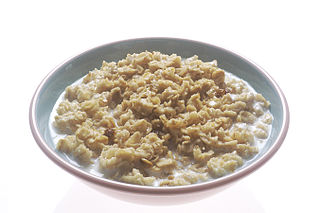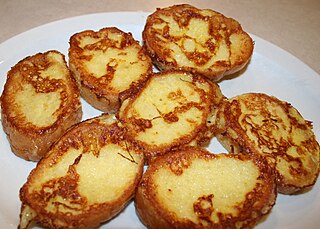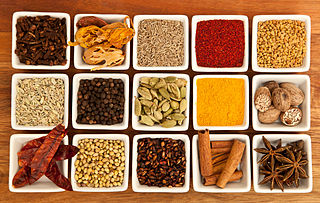
Porridge is a food made by heating or boiling ground, crushed or chopped starchy plants, typically grain, in milk or water. It is often cooked or served with added flavourings such as sugar, honey, (dried) fruit or syrup to make a sweet cereal, or it can be mixed with spices, meat or vegetables to make a savoury dish. It is usually served hot in a bowl, depending on its consistency. Oat porridge, or oatmeal, is one of the most common types of porridge. Gruel is a thinner version of porridge.

French toast is a dish made of sliced bread soaked in beaten eggs, sugar and typically milk, then pan fried. Alternative names and variants include "eggy bread", "Bombay toast", "gypsy toast", and "poor knights".

Pudding is a type of food that can be sweet or savoury, cooked or uncooked depending on where and when it is made.

Coddle is an Irish dish which is often made to use up leftovers, and therefore without a specific recipe. However, it most commonly consists of layers of roughly sliced sausages and rashers with chunky potatoes, sliced onion, salt, pepper, and herbs. Traditionally, it can also include barley.

Boxty is a traditional Irish potato pancake. The dish is mostly associated with the north midlands, north Connacht and southern Ulster, in particular the counties of Leitrim, Mayo, Sligo, Donegal, Fermanagh, Longford, and Cavan. There are many recipes but all contain finely grated, raw potatoes and all are served fried.

Liptauer is a spicy cheese spread from Slovakian, Austrian and Hungarian cuisine. Liptauer is made with sheep milk cheese, goat cheese, quark, or cottage cheese.

Potato bread is a form of bread in which potato flour or potato replaces a portion of the regular wheat flour. It is cooked in a variety of ways, including baking it on a hot griddle or pan, or in an oven. It may be leavened or unleavened, and may have a variety of other ingredients baked into it. The ratio of potato to wheat flour varies significantly from recipe to recipe, with some recipes having a majority of potato, and others having a majority of wheat flour. Some recipes call for mashed potatoes, with others calling for dehydrated potato flakes. It is available as a commercial product in many countries, with similar variations in ingredients, cooking method, and other variables.

Colcannon is a traditional Irish dish of mashed potatoes with cabbage or kale.

The cuisine of Botswana is unique but shares some characteristics with other cuisines of Southern Africa. Examples of Setswana food include pap, samp, vetkoek, bogobe and mophane worms. A food unique to Botswana is seswaa, salted mashed-up meat.

Barmbrack, also often shortened to brack, is a quick bread with added sultanas and raisins. The bread is associated with Halloween in Ireland, where an item is placed inside the bread, with the person who receives it considered to be fortunate.

Sindhi cuisine refers to the distinct native cuisine of the Sindhi people from the Sindh region, in India and Pakistan. Sindhi cuisine has been influenced by South Asian, Central Asian, Iranian, Mughal food traditions. It is mostly a non-vegetarian cuisine, with even Sindhi Hindus widely accepting of meat consumption. The daily food in most Sindhi households consists of wheat-based flat-bread (phulka) and rice accompanied by two dishes, one gravy and one dry with curd, papad or pickle. Freshwater fish and a wide variety of vegetables are usually used in Sindhi cuisine. Restaurants specializing in Sindhi cuisine are rare, although it is found at truck stops in rural areas of Sindh province, and in a few restaurants in urban Sindh.

Yemeni cuisine is distinct from the wider Middle Eastern cuisines, but with a degree of regional variation. Although some foreign influences are evident in some regions of the country, the Yemeni kitchen is based on similar foundations across the country.

Champ is an Irish dish of mashed potatoes with scallions, butter, and milk.

Irish cuisine encompasses the cooking styles, traditions and recipes associated with the island of Ireland. It has evolved from centuries of social and political change and the mixing of the different cultures, predominantly with those from nearby Britain and other European regions. The cuisine is founded upon the crops and animals farmed in its temperate climate and the abundance of fresh fish and seafood from the surrounding waters of the Atlantic Ocean. Chowder, for example, is popular around the coasts.

A meal is an eating occasion that takes place at a certain time and includes prepared food. The names used for specific meals in English vary, depending on the speaker's culture, the time of day, or the size of the meal.

Bríd Mahon was an Irish folklorist and writer. She began her career as a child, writing a radio script on the history and music of County Cork for Radio Éireann. Hired to work as a typist for the Irish Folklore Commission, she would remain at the commission until 1970. During her time at the commission, she developed a second career as a journalist, serving as a theatre critic and writing the women's page for The Sunday Press. Her juvenile fiction, The Search for the Tinker Chief, was optioned by Disney, after becoming a bestseller and though she was discouraged from publishing information collected on Irish folklore, she conducted research and published non-fiction works on Irish clothing and food. When the Commission was disbanded in 1970, Mahon worked as a folklorist and lecturer at University College Dublin and later taught at the University of California.
















